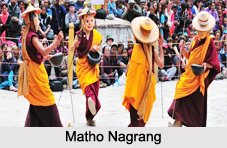 Festivals in Ladakh point the national integration, ancient and medieval Buddhist cultural traditions and ancestral customs influenced from Buddhist and Tibetan art and culture. The vibrant festivals in Ladakh are not only important in the cultural hemisphere of Jammu and Kashmir, but also in promoting the tourism industry in Leh- Ladakh.
Festivals in Ladakh point the national integration, ancient and medieval Buddhist cultural traditions and ancestral customs influenced from Buddhist and Tibetan art and culture. The vibrant festivals in Ladakh are not only important in the cultural hemisphere of Jammu and Kashmir, but also in promoting the tourism industry in Leh- Ladakh.
Ladakh Festival
Ladakh festival is celebrated from 20th to 26th September, every year in Leh. The inauguration ceremony of Ladakh festival takes place in Leh on a large scale with a procession of several cultural troupes from different part of the region which traverses through Leh Market.
Thiksey Gustor
Thiksey Gustor is a two day festival celebrated in Ladakh region of Jammu and Kashmir. This festival is celebrated at various monasteries of Thikse Monastery, Spituk Monastery and Karsha Nanzkar Monastery.
Galdan Namchot festival
 Galdan Namchot festival in Ladakh is celebrated for commemorating the birthday and the Buddha hood of the Tibetan saint-scholar, Tsongkhapa. He was the founder of the Gelukpa School that preaches Tibetan Buddhism during the 14th century. This festival means the starting of the New Year celebrations in Ladakh that goes on till the Dosmoche festival.
Galdan Namchot festival in Ladakh is celebrated for commemorating the birthday and the Buddha hood of the Tibetan saint-scholar, Tsongkhapa. He was the founder of the Gelukpa School that preaches Tibetan Buddhism during the 14th century. This festival means the starting of the New Year celebrations in Ladakh that goes on till the Dosmoche festival.
Galdan Namchot
Galdan Namchot is celebrated as the birth anniversary of Tsogkha pa. He was the founder of Gelukpa School. The Losar festivities begin from that time. Losar Festival falls in the 11th month of Tibetan calendar. It is 2 months ahead of Tibetan New Year. In the 17th century, King Jamyang Namgyal thought about leading an expedition against the Baltistan forces in winter, as well as a celebration of the festival. During the festival, Gods, ancestors and animals are fed properly without delay.
Matho Nagrang
Matho Nagrang is celebrated at a Matho monastery on the 15th day of the 1st month of the Tibetan calendar. This monastery of Ladakh is the only one belonging to the Sakya School of Tibetan Buddhism. During this two day festival, there are mask dance performances by monks of the monastery while wearing colorful silk brocaded robes and mask depicting various forms of God and Goddesses.
Saga Dawa festival
Saga Dawa festival is celebrated on the 4th month of the Tibetan calendar. It is the most revered day for Buddhist followers as on this full moon of this month, Gautama Buddha was born, attained enlightenment and then Nirvana. On this very day, every year, the lamas of nearby monasteries change the Tarboche flag pole that is located at the South of the mountain, Kailash Kora.
Sindhu Darshan
 Sindhu Darshan is celebrated in Shey Manla. It is located about 8 kms away from the main city of Leh. This is a 3-day festival, which happens from 1st to 3rd June on the bank of Indus river in India counterpart. The celebrations of this festival were started in the month of October 1997, for the celebration of unity as well as communal harmony along with the national integration.
Sindhu Darshan is celebrated in Shey Manla. It is located about 8 kms away from the main city of Leh. This is a 3-day festival, which happens from 1st to 3rd June on the bank of Indus river in India counterpart. The celebrations of this festival were started in the month of October 1997, for the celebration of unity as well as communal harmony along with the national integration.
Yuru Kabgyat
Yuru Kabgyat is a two-day festival that takes place in the month of July in the Lamayuru monastery. This monastery is located around 125 kms away from Leh. During the festival, the monks perform mask dances, prayers and rituals in order to get away from any kind of disaster and for bringing in peace in the world.
Related Articles
Monasteries in Ladakh
Jammu and Kashmir
Tourism in Jammu and Kashmir
Ladakh
North Indian Village Festivals



















